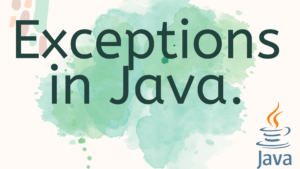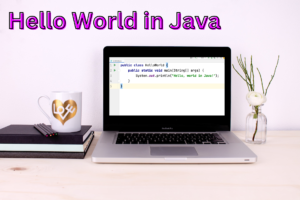Introduction
Java, being a versatile and widely-used programming language, relies on a robust error-handling mechanism to manage unexpected events during program execution. Errors vs. exceptions in Java are both essential components of this mechanism, but they serve different purposes.
Table of Errors vs. Exceptions in Java
What are Errors in Java?
Errors in Java are serious issues that typically occur at the system level, affecting the JVM (Java Virtual Machine) and the execution of the program as a whole. They are often unrecoverable, and it is generally not advisable to catch or handle errors in your code. Some common examples of errors include:
- Syntax errors, also known as compilation errors, occur during the compilation phase of your Java program. They are caused by violations of the rules of the Java programming language’s syntax. These rules dictate the structure and format of your code, and any deviation from them results in a syntax error.
- Runtime errors, also known as exceptions, occur during the execution of your Java program. They result from unexpected or exceptional conditions that occur while the program is running. Unlike syntax errors, runtime errors may not be apparent until you execute the program and reach the point in the code where the error occurs.
- Logical errors, also known as bugs, are the most subtle and challenging type of error to identify and fix. They occur when the program’s code does not produce the expected or desired output. Logical errors are not detected by the compiler or runtime system; instead, they stem from incorrect program logic or algorithmic flaws.
Errors are usually beyond the control of the programmer and indicate serious issues that should be addressed at the system level. They are not intended to be caught and handled in code.
What are Exceptions in Java?
On the other hand, exceptions in Java are events that occur during the execution of a program but can be managed and handled by the developer. Exceptions are objects that represent error conditions and can be caught, allowing you to take appropriate action to recover or gracefully terminate the program.
Exceptions can be further divided into two categories: checked and unchecked exceptions.
- Checked Exceptions: These are exceptions that are checked at compile time, and the developer is required to handle them using
try-catchblocks or declaring them in the method signature using thethrowskeyword. Examples includeFileNotFoundExceptionandSQLException. - Unchecked Exceptions: Also known as runtime exceptions, these exceptions do not need to be explicitly handled and can occur at runtime. They are subclasses of
RuntimeException. Examples includeNullPointerExceptionandArrayIndexOutOfBoundsException.
Errors vs. Exceptions in Java diagram

Differences Between Errors vs. Exceptions in Java
Let’s dive deeper into the distinctions between errors vs. exceptions in Java:
| Aspect | Errors | Exceptions |
|---|---|---|
| Nature | System-level issues | Programmer or application-level issues |
| Handling | Not typically caught or handled | Encouraged to be caught and handled |
| Recoverability | Usually unrecoverable | Can be recovered or handled gracefully |
| Checked/Unchecked | Not applicable | Checked and unchecked exceptions |
| Examples | OutOfMemoryError, StackOverflowError | FileNotFoundException, NullPointerException |
When to Use Errors vs. Exceptions in Java
It’s important to understand when to use errors vs. exceptions in your Java programs.
- Use errors for situations that are beyond your control and indicate severe system-level issues. In most cases, it’s best to let the JVM handle these errors, as there may be little you can do at the application level to recover from them.
- Use exceptions for events that can be managed and recovered from within your application. This includes both checked and unchecked exceptions, where you should catch and handle exceptions where appropriate and let others propagate when necessary.
Best Practices for Handling Exceptions in Java
To effectively manage exceptions in Java, here are some best practices:
- Catch Exceptions Selectively: Catch only those exceptions that you can handle or those that make sense in your context. Avoid catching and ignoring exceptions, as this can lead to unexpected behavior and make debugging difficult.
- Use Multiple Catch Blocks: If your code can throw multiple types of exceptions, use separate
catchblocks for each exception type to handle them differently. - Finally Block: Utilize the
finallyblock to ensure that essential cleanup or resource release tasks are always executed, whether an exception is thrown or not. - Logging: Always log exceptions or error messages to facilitate debugging and troubleshooting. This can be incredibly helpful in diagnosing issues in production.
- Custom Exception Handling: In some cases, you may need to create custom exception classes to represent specific application-level errors that are not adequately covered by standard Java exceptions.
Examples
Example 1: Handling a Checked Exception
import java.io.File;
import java.io.FileNotFoundException;
import java.util.Scanner;
public class FileReadExample {
public static void main(String[] args) {
try {
File file = new File("nonexistentfile.txt");
Scanner scanner = new Scanner(file);
while (scanner.hasNextLine()) {
System.out.println(scanner.nextLine());
}
scanner.close();
} catch (FileNotFoundException e) {
System.out.println("The file was not found.");
e.printStackTrace();
}
}
}
In this example, we are attempting to read from a file that may not exist. We use a try-catch block to catch the FileNotFoundException, which is a checked exception. If the file does not exist, the code in the catch block is executed, and an error message is printed.
Example 2: Unchecked Exception
public class DivideByZeroExample {
public static void main(String[] args) {
int numerator = 10;
int denominator = 0;
try {
int result = numerator / denominator;
System.out.println("Result: " + result);
} catch (ArithmeticException e) {
System.out.println("An arithmetic error occurred: " + e.getMessage());
}
}
}
In this example, we attempt to divide by zero, which results in an ArithmeticException, an unchecked exception. We use a try-catch block to catch and handle this exception, preventing the program from crashing. The catch block prints an error message.
Example 3: Handling an Error
Errors are typically not caught and handled in code because they represent system-level issues. However, you can still include a simple example to show what happens when an error occurs.
public class StackOverflowExample {
public static void main(String[] args) {
recursiveMethod();
}
public static void recursiveMethod() {
recursiveMethod();
}
}
In this example, we create a recursive method that calls itself endlessly. This leads to a StackOverflowError, an error that occurs when the call stack exceeds its limit. We don’t catch this error in code because it’s beyond our control and should be handled at the system level.
These examples demonstrate how errors and exceptions work in Java and how to handle them using try-catch blocks for exceptions while leaving errors unhandled.
Conclusion
In Java, understanding the differences between errors vs. exceptions in Java is crucial for writing robust and reliable code. Errors are severe system-level issues that are typically unrecoverable and best left to the JVM to handle. Exceptions, on the other hand, are events that can be caught, handled, and managed within your application.



